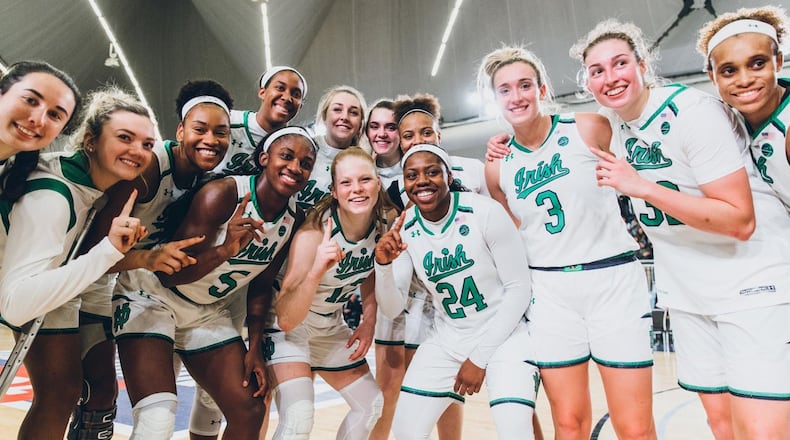Prohaska suffered blood clots in both her lungs, a condition known as bilateral pulmonary embolism that rarely impacts individuals her age, but months later, she believes she has overcome one nurse’s indication her career might be in jeopardy.
»RELATED: OHSAA ‘optimistic’ about high school football this fall
“It’s been a slow and steady process,” Prohaska said Friday. “I’m beyond relieved just because in the beginning the doctors didn’t necessarily know at what percentage I would get back since it’s so uncommon in my age group. I feel nearly 100 percent, and it’s a huge breath of fresh air because there was so much uncertainty. I’m excited to get back out there.”
Prohaska’s health scare started with a gastrointestinal issue at the beginning of October as Notre Dame was preparing for the 2019-20 season. When that seemed to get better, she didn’t think anything of it, but Oct. 14 she started experiencing a sharp pain in her right shoulder and could barely keep up during a team scrimmage. A few practices before that, she had noticed shortness of breath and wrote it off as her asthma acting up, but this time was different and the pain only grew worse at night.
The next day, the team doctor suggested she go to the emergency room, where she went through a series of tests before a CT scan finally showed the problem. In addition to blood clots in both lungs, she had an infarct on her right side, which meant that part of her lung wasn’t getting enough blood circulation, so it was dying off. Doctors eventually discovered that a medication she had been taking, combined with a specific gene in her blood made her more prone to clotting.
“I got really worried when the pain got super bad because I wasn’t getting answers until I went to the ER and got the CT scan,” Prohaska said. “Then, it was just like, ‘OK, what do we do now?’ This nurse came in and dropped it: ‘You’re 19 and have pulmonary embolism. I’m so sorry to hear that. You might never play again.’ That caught me off guard. In that moment I realized how serious it was. There was a possibility I might not return, but I was blessed it wasn’t career-ending.”
»CORONAVIRUS: More sports restrictions lifted in Ohio
Prohaska was put on blood thinners and monitored for three days in the hospital before she was released. But the protocol to return was three to six months, depending on when she could get off the blood thinners.
She took off an entire month, then slowly progressed to biking for three or four weeks, then some light body weight lifting. By the three-month mark, her lab work indicated she was clear to get off the blood thinner and she had a decision to make. She could either return to play or take a medical redshirt. The latter seemed the wiser choice.
“I didn’t feel ready,” Prohaska said. “My body had been through a lot of trauma and being an athlete that has asthma, I wasn’t in shape with my lungs to come back.”
Notre Dame went on to a disappointing 13-18 finish after going 35-4 and falling to Baylor in the NCAA championship game the year prior. Prohaska had played in 38 games, mostly coming off the bench, but had expected to play a bigger role as a sophomore.
Instead, all she could do was practice and slowly work herself into scrimmages, watching games from the bench.
“Any athlete wants to be out there giving their all, and the fact I couldn’t go through the season physically was hard for me, especially because it wasn’t the best season for Notre Dame women’s basketball,,” she said. “I had to humble myself a little bit and realize there is a lot more to basketball than I was thinking at the time.”
Prohaska said although she didn’t play a game that season, it was the year in which she experienced the most growth. She learned to view the game differently from the sidelines and serve as a player-coach for her teammates, which allowed her to develop even more as a leader.
Next season, she hopes that pays off for a big year. She’s running two miles every other day, working on conditioning daily and building up strength in preparation – even while knowing in the back of her mind there is still uncertainty because of the COVID-19 pandemic potentially jeopardizing sports.
“I definitely have a lot of team goals and personal goals just because I’ve been able to watch and see this past season what we need team wise and also what I can bring that maybe the team didn’t have,” she said. “I have something to prove and I believe our team has a point to prove, so I have a lot of motivation and hope for this next season.”
About the Author
